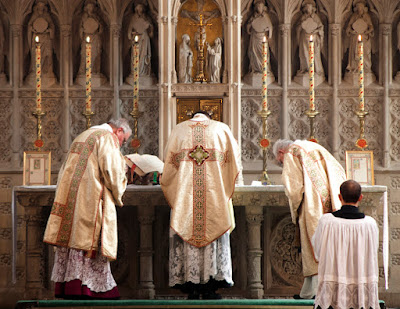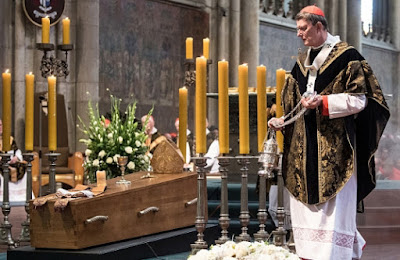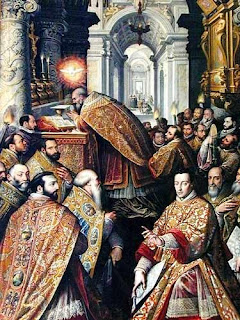 |
| Figure 1 S. Charles Borromeo. Image : National Library of Victoria. |
 |
Figure 2
Vestments of S. Charles Borromeo on display
in the Basilica of S. Mary's Major, Rome. |
So, why was the chasuble drastically modified? Let us answer that question by first tracing the origin and early development of this garment.
 |
Figure 3
Archbishop Maximian (at right)
wearing the planeta and pallium.
Church of S' Vitale Ravenna
6th century.
|
 |
Figure 4
Conical chasuble of S' Vitalis, 11th century.
A braid covers the seam in the centre
of the chasuble and reinforces
the opening of the neckline.
|
It was only from the time of its use exclusive use by the celebrant of the Mass in the 11th century that its decoration became more ornate.
 |
Figure 5
Modern conical chasuble worn
by an American bishop and shewing how this form
of chasuble folds up on the arms
of the wearer.
|
How what is modified? Modification happened in stages and not uniformly across the Church in the West. In the first instance, the semi-circular shape of the chasuble was cut back in such a way that the bulk of fabric to be supported on the arms was reduced. Subsequently, shoulder seams were introduced and the length of that seam reduced from the conical form. The chasuble of S’ Thomas Becket is an example of this earliest modification (see figures 6-7). Notice that what had been a bell-shaped garment has become pointed. Once shoulder seams were introduced, it became possible progressively to reduce the length of that seam. The chasuble attributed to Saint Bernard is another example of this modified form.
 |
Figure 7
16th century chasuble shewing
the modification to reduce the slope of the shoulders and the
width of the vestment
compared with
the earlier conical form.
|
Not content with that, however, vestment makers cut back the width of the chasuble more and more. These latter modifications (beginning in Northern Europe in the 15th century), went beyond what was needed to make the chasuble more practical for the celebrant to wear. In the 16th century, Saint Charles, objecting to these extreme modifications, laid down his regulations to remind priests and vestment-makers of the importance of preserving the centuries-old Tradition. It was obviously regarded by S. Charles as most important that the chasuble continue to be a garment that fully covered the celebrant, being both long (reaching almost to the heels) and wide (51 inches, between the elbow and the wrist).
When “The Borromeon style” of chasuble is referred to, it is important to remember that the cut of chasubles varied and were the work of craftsmen, not mass-manufacturers. We can be rather sure that the vestments used by Saint Charles himself were not all precisely the same in cut. Furthermore, other styles were also prominent in the 16th and 17th centuries. One style we find in the various paintings of Saint Charles’ contemporary, Philip Neri. This chasuble was narrower than the 51 inches set down by S. Charles, but it was still very long. A variant of this “Philip Neri” style of chasuble was found in northern parts of Europe and in England. Yet another form, the Spanish style, is depicted in the famous painting of Saint Idelfonso.
Something might be included here about the ornamentation of chasubles. The early casula and planeta largely lacked any form of ornamentation. Because there was but one seam that formed the garment into its bell shape, that seam (which ran vertically down the front of the chasuble) came to be covered with a narrow braid-like band. In order to strengthen the fabric around the opening for the head, braid was also added. This is the origin – purely practical – of what is referred to as the “tau” style of ornament (“tau” being the letter of the Greek alphabet which corresponds to our “tee”).
It was a logical step from here to find that a corresponding strip of braid was applied to the back of the chasuble (even though it was purely decorative and not supporting seams etc.). The width of these braid-like ornaments came to be increased over the centuries from something that was no more than 3 – 5cm to something that became up to 20cm in width. And, very early on in the development of the chasuble, these strips ceased to be purely functional and became the focus of elaborate ornament and embroidery.
By the 14th century the chasuble had come to be ornamented in three common forms (with many variations). One is the Y-shaped orphrey (thought to be derived from Roman and Jewish ceremonial garb), which was mainly found in Northern Europe and England. Another is the “tau” shaped orphrey, which was an ornament applied to the front of the chasuble, but with the back of the chasuble ornamented with a simple column. This was the usual Italian or Roman style. The third form consisted of the back being decorated with a Latin Cross. This last style was not so frequently found in Italy, but was very common elsewhere in Europe.
 |
Figure 10
Forms of chasuble ornament.
A German chasuble of the 16th century,
shewing the Crucifixion scene form of orphrey.
|
We should also be careful about the use of the term “Roman” vestments. Roman vestments are those used for the Roman Rite: they do not refer to any particular style or shape. The pendant-style chasuble did not have its origin in Rome, but in northern Europe. Rome did not readily adopt it. Saint Charles legislated against it.
From the 19th century, scholars began promoting a return to the earlier, more ample style of chasuble. We find such chasubles appearing in England and parts of Europe. Sometimes these are referred to as “Gothic” vestments, although it is not certain why. These “Gothic” vestments were similar to the proportions insisted upon by S. Charles. Strangely, Rome (which for two centuries had held out against the introduction of the pendant-like vestments) did not welcome the 19th century interest in reviving these “Gothic” or “Borromeon” chasubles and in 1863 letter warned against the use of vestments that departed from the “received form”. How short, it would seem, was the Roman memory.
 |
| Figure 12 Gothic Revival Solemn Mass set designed by AWN Pugin for S. Edmund's College Ware (UK) Image : LMS Society of Great Britain |
 |
| Figure 13 A Gothic Revival chasuble of great dignity used for the Requiem of Cardinal Meisner at the Cathedral Cologne in 2017. |
In December 1925, at a time when vestment-makers in Europe and beyond were creating magnificent chasubles of Borromeon proportions, the Congregation of Rites published a rescript that the more ample form of chasuble was not to be used for the Roman Rite, except by special permission of the Holy See. What a peculiar decision this was, given that earlier in the same year an Exhibition of the Liturgical Arts had been held in Rome and newly-made vestments, according to the Borromeon proportions, were shown in a special audience with Pius XI, who approved their use and blessed them. A famous photograph exists of Pius XI celebrating Mass in S’ Peter’s in a 16th century style chasuble: some years after his Congregation of Rites had attempted to prohibit their use!
The 1925 letter of the Congregation - which had been widely ignored, especially in Europe - was reversed by a new decision in August 1957, granting Diocesan bishops leave to permit the use of the more ample form of chasuble. Eight years later (1965), Rome herself followed what was already occurring world-wide. The 18th century style of vestments used in Papal ceremonial was replaced with something very different but austere: somewhat like the ethos of the 1960’s itself. Somebody put to me once that many people were greatly upset and even scandalised when Papal Rome made this change. Consequently, and for precisely this reason, there is a very negative attitude amongst some to modern expressions in the style of vestments. And, to be frank, concerning vestments made from the 1970’s onward, there is ample scope for negativity.
But had 1960’s Rome just invented a new style of vestment and thrown out Tradition? In fact, no. The vestments which emerged in Rome from the mid-1960’s were a modern “take” on the Borromeon form of chasuble (see figures 15-16): this was a return to an earlier tradition. It is a pity that Rome did not take the trouble to make that point very clear. Comparison of the picture of the Borromeon chasuble in Saint Mary’s Major with chasubles worn by Pope Paul will illustrate this very clearly: the form is almost the same.
 |
| Figure 17 Pope S. John Paul II wearing an Italian chasuble, being a modern interpretation of the Borromeon form. |
 |
| Figure 18 Pope Benedict XVI wearing a magnificent chasuble of violet and gold damask, a modern reproduction of the Borromeon form. |
If 1960’s Rome had decided to use beautiful and elaborate damasks for the Papal vestments instead of the plainest of silk, perhaps attitudes to the new Papal array might have been different. For, if anything, the vestments of post-Vatican II Papal Rome have lacked creativity and splendour. During the later years of the pontificate of Pope S. John Paul II, however, and frequently during the reign of Pope Benedict, we observed vestments of greater beauty, made from beautiful damasks and brocades and ornamented in a most artistic manner. Unhappily this progress towards greater beauty for the Papal vestments has completely disappeared since 2013, along with so much else.
The above is a revised version of an article first posted on this blog in 2008.
SELECT BIBLIOGRAPHY
This article has attempted to be a comprehensive, but not an in-depth, study of the history of the chasuble. Consider it more as an illustrated lecture than a scholarly treatise. I refer you to these works for more detailed information:
Die liturgische Gewandung im Occident und Orient, Joseph Braun, 1907
The Vestments of the Roman Rite, Adrian Fortescue, 1912
Vestments and Vesture, Dom E Roulin, 1930
The Catholic Encyclopaedia (1911) and The New Catholic Encyclopaedia (1967)
High Fashion in the Church, Pauline Johnstone, 2002
A Dictionary of Liturgy and Worship, 1972.






